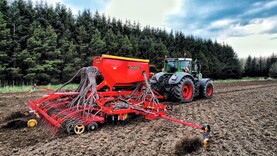Earthworms are hugely important for the health and productivity of land, whether in grassland or tillage, but many farmers are not aware of their benefits. In Ireland, we have 28 known earthworm species, which feed on and break down organic matter. Each species has its own specific role in the soil.
 “Earthworms play a role in the breakdown of plant litter and animal manures. Plant litter and decomposing dung, such as farmyard manure (FYM), slurry and other organic matter (OM), are broken down and decomposed faster by earthworms,” explains UCD soil lecturer Dr Olaf Schmidt (right).
“Earthworms play a role in the breakdown of plant litter and animal manures. Plant litter and decomposing dung, such as farmyard manure (FYM), slurry and other organic matter (OM), are broken down and decomposed faster by earthworms,” explains UCD soil lecturer Dr Olaf Schmidt (right).
He says that earthworms distribute the nutrients through their excrement along the soil profile, leaving behind worm casts. The blending of organic substances, microrganisms and fine mineral soil particles, which occurs during the digestion process in earthworms, releases plant nutrients and helps to restructure soil to improve the land in the long term.
Schmidt says: “There is a misconception among some people that earthworms add nutrients to the soil. They don’t add nutrients to the soil because they can’t miraculously make them. What they can do is to feed selectively on hotspots containing decaying roots or a patch where manure is present.’’

Like every other organism, they respond to the availability of food. “When you examine worm casts (above), it looks like they have enriched the nutrients present but they haven’t really. It is not a matter of an earthworm increasing the available nutrients, just because it consumed the soil. If and when earthworms die, they themselves release a lot of nitrogen and phosphorus as they decay, but these nutrients were also extracted from the soil originally.”
Nitrogen-rich slime
Studies have shown that earthworms excrete available nitrogen and mucus all the time and the amounts are significant. Earthworms extrude slime from their skin to help lubricate their movement and this contains a lot of nitrogen, which is deposited along the burrow. What they really do is to help make nutrients available to plants.
In the soil ecosystem, they help degrade organic material to ultimately make these nutrients available to plant roots for uptake. They speed up the mineralisation of all types of manures and plant residue, which all contain plant nutrients. They act as decomposers to help free the nutrients that are bound in lignin and cellulose structures and make them available to plants.
Schmidt says: “Deep-burrowing earthworms move down through the soil horizons and pull large plant parts down with them from the surface. This plant material is decomposed in their burrows as the worms feed on the decaying plant. The nutrients eventually released can be taken up by deep rooting plants.”
Soil structure is greatly improved by the presence of earthworms. Darwin described earthworms as “nature’s ploughmen” because of their ability to move and aerate soil. They help to create small tubes called macro-pores, which facilitate the movement of air and water through the soil.
How to increase earthworm numbers in your soil?
Feeding for growth: The main way you can help to increase worm numbers is to feed them. Earthworms are one of nature’s few biodiversity organisms that thrive on well-managed intensive systems. Worms live where there is food, moisture, a favourable temperature and little disturbance. Without all of these requirements, they would prefer to be somewhere else and numbers would decrease. Farmers can adjust their farming systems in different ways to encourage increases in worm populations.

Firstly, spreading partially decomposed FYM on land is very beneficial. This decaying matter is a good feed source for the worms and it will lead to an increase in population numbers. Slurry also has a part to play in feeding earthworms, but the way it is spread must change on many farms if you want worm numbers to increase. Avoid spreading slurry when fields are very wet and try not to spread slurry too thick. Little and often may be a better approach rather than one large thick coat. It is not uncommon for a number of earthworms to die following slurry application, but the population should quickly increase again as a result of the high amount of organic feed available and better pasture growth.
Avoid excessive tilling: Avoid tilling land excessively, especially during active times. Earthworms tend to be very active in March/April and September/October, so if you can avoid tilling land excessively during these periods you will help to maintain numbers. Irish research has shown that minimum tillage techniques can help in this regard. 
For tillage farmers, straw incorporation could be a way of building OM on their farm. This is an excellent food source for the earthworms and it helps to increase numbers. In years such as 2014, when straw prices were low, it makes financial sense to chop and incorporate straw rather than having bales lying in the field.
Balanced pH: Research carried out in Irish grassland showed that worm populations expanded when nitrogen input increased. However, there are limits to the amount of chemical nitrogen that Irish farmers can spread and too much nitrogen can lead to soil acidity. Earthworms are sensitive to soil pH and numbers will drop if the pH drops below five. 
 Vary your tracks: Compacted soils do not suit earthworms. If soil is very compacted, it makes it harder for earthworms to burrow through and do their work. By alternating your tracks when travelling on the land, you will reduce the damage to the soil. Avoid travelling on the ground when it is very wet and do not let animals out to poach the ground in wet weather. Conditions like these can have a negative effect on earthworm populations.
Vary your tracks: Compacted soils do not suit earthworms. If soil is very compacted, it makes it harder for earthworms to burrow through and do their work. By alternating your tracks when travelling on the land, you will reduce the damage to the soil. Avoid travelling on the ground when it is very wet and do not let animals out to poach the ground in wet weather. Conditions like these can have a negative effect on earthworm populations. Soil compaction is a physical disturbance of the soil which generally causes a decrease in soil porosity and an increase in bulk density, which leads to unfavourable conditions for soil organisms and root growth.
Does slurry kill earthworms?
Many farmers believe that applying slurry to land kills earthworm populations, but Dr. Olaf Schmidt says that this is not the case and slurry may, in fact, help increase worm numbers in the long term.
Studies have shown that slurry application at normal rates either had “no effect or had a positive effect on earthworm populations”.
This study was carried out over four years.
He says: “Yes, you can see worms being expelled following slurry application and these can be taken by seagulls. However, in the long term, slurry application adds to the soil.
‘‘Slurry is not detrimental to overall populations. Here in Ireland, we have approximately 500 worms per square metre. That is 5,000,000 worms per hectare.
‘‘If you saw five worms dead on top in one of these square metres, this is only 1%. Olaf feels that one-off events are not that significant and he suspects that it is the exposure to UV light, or seagulls, that kills them. In the long run, populations are not affected and may actually increase.

Dr Olaf Schmidt is a senior lecturer in agri-environmental sciences in UCD since 2008. His main research interests are in soil science, in particular in the biology, biodiversity, ecology and biochemistry of soils in the context of soil-plant-animal systems. He especially likes earthworms as a study subject.
This article was first published in July 2015.
Earthworms are hugely important for the health and productivity of land, whether in grassland or tillage, but many farmers are not aware of their benefits. In Ireland, we have 28 known earthworm species, which feed on and break down organic matter. Each species has its own specific role in the soil.
 “Earthworms play a role in the breakdown of plant litter and animal manures. Plant litter and decomposing dung, such as farmyard manure (FYM), slurry and other organic matter (OM), are broken down and decomposed faster by earthworms,” explains UCD soil lecturer Dr Olaf Schmidt (right).
“Earthworms play a role in the breakdown of plant litter and animal manures. Plant litter and decomposing dung, such as farmyard manure (FYM), slurry and other organic matter (OM), are broken down and decomposed faster by earthworms,” explains UCD soil lecturer Dr Olaf Schmidt (right).
He says that earthworms distribute the nutrients through their excrement along the soil profile, leaving behind worm casts. The blending of organic substances, microrganisms and fine mineral soil particles, which occurs during the digestion process in earthworms, releases plant nutrients and helps to restructure soil to improve the land in the long term.
Schmidt says: “There is a misconception among some people that earthworms add nutrients to the soil. They don’t add nutrients to the soil because they can’t miraculously make them. What they can do is to feed selectively on hotspots containing decaying roots or a patch where manure is present.’’

Like every other organism, they respond to the availability of food. “When you examine worm casts (above), it looks like they have enriched the nutrients present but they haven’t really. It is not a matter of an earthworm increasing the available nutrients, just because it consumed the soil. If and when earthworms die, they themselves release a lot of nitrogen and phosphorus as they decay, but these nutrients were also extracted from the soil originally.”
Nitrogen-rich slime
Studies have shown that earthworms excrete available nitrogen and mucus all the time and the amounts are significant. Earthworms extrude slime from their skin to help lubricate their movement and this contains a lot of nitrogen, which is deposited along the burrow. What they really do is to help make nutrients available to plants.
In the soil ecosystem, they help degrade organic material to ultimately make these nutrients available to plant roots for uptake. They speed up the mineralisation of all types of manures and plant residue, which all contain plant nutrients. They act as decomposers to help free the nutrients that are bound in lignin and cellulose structures and make them available to plants.
Schmidt says: “Deep-burrowing earthworms move down through the soil horizons and pull large plant parts down with them from the surface. This plant material is decomposed in their burrows as the worms feed on the decaying plant. The nutrients eventually released can be taken up by deep rooting plants.”
Soil structure is greatly improved by the presence of earthworms. Darwin described earthworms as “nature’s ploughmen” because of their ability to move and aerate soil. They help to create small tubes called macro-pores, which facilitate the movement of air and water through the soil.
How to increase earthworm numbers in your soil?
Feeding for growth: The main way you can help to increase worm numbers is to feed them. Earthworms are one of nature’s few biodiversity organisms that thrive on well-managed intensive systems. Worms live where there is food, moisture, a favourable temperature and little disturbance. Without all of these requirements, they would prefer to be somewhere else and numbers would decrease. Farmers can adjust their farming systems in different ways to encourage increases in worm populations.

Firstly, spreading partially decomposed FYM on land is very beneficial. This decaying matter is a good feed source for the worms and it will lead to an increase in population numbers. Slurry also has a part to play in feeding earthworms, but the way it is spread must change on many farms if you want worm numbers to increase. Avoid spreading slurry when fields are very wet and try not to spread slurry too thick. Little and often may be a better approach rather than one large thick coat. It is not uncommon for a number of earthworms to die following slurry application, but the population should quickly increase again as a result of the high amount of organic feed available and better pasture growth.
Avoid excessive tilling: Avoid tilling land excessively, especially during active times. Earthworms tend to be very active in March/April and September/October, so if you can avoid tilling land excessively during these periods you will help to maintain numbers. Irish research has shown that minimum tillage techniques can help in this regard. 
For tillage farmers, straw incorporation could be a way of building OM on their farm. This is an excellent food source for the earthworms and it helps to increase numbers. In years such as 2014, when straw prices were low, it makes financial sense to chop and incorporate straw rather than having bales lying in the field.
Balanced pH: Research carried out in Irish grassland showed that worm populations expanded when nitrogen input increased. However, there are limits to the amount of chemical nitrogen that Irish farmers can spread and too much nitrogen can lead to soil acidity. Earthworms are sensitive to soil pH and numbers will drop if the pH drops below five. 
 Vary your tracks: Compacted soils do not suit earthworms. If soil is very compacted, it makes it harder for earthworms to burrow through and do their work. By alternating your tracks when travelling on the land, you will reduce the damage to the soil. Avoid travelling on the ground when it is very wet and do not let animals out to poach the ground in wet weather. Conditions like these can have a negative effect on earthworm populations.
Vary your tracks: Compacted soils do not suit earthworms. If soil is very compacted, it makes it harder for earthworms to burrow through and do their work. By alternating your tracks when travelling on the land, you will reduce the damage to the soil. Avoid travelling on the ground when it is very wet and do not let animals out to poach the ground in wet weather. Conditions like these can have a negative effect on earthworm populations. Soil compaction is a physical disturbance of the soil which generally causes a decrease in soil porosity and an increase in bulk density, which leads to unfavourable conditions for soil organisms and root growth.
Does slurry kill earthworms?
Many farmers believe that applying slurry to land kills earthworm populations, but Dr. Olaf Schmidt says that this is not the case and slurry may, in fact, help increase worm numbers in the long term.
Studies have shown that slurry application at normal rates either had “no effect or had a positive effect on earthworm populations”.
This study was carried out over four years.
He says: “Yes, you can see worms being expelled following slurry application and these can be taken by seagulls. However, in the long term, slurry application adds to the soil.
‘‘Slurry is not detrimental to overall populations. Here in Ireland, we have approximately 500 worms per square metre. That is 5,000,000 worms per hectare.
‘‘If you saw five worms dead on top in one of these square metres, this is only 1%. Olaf feels that one-off events are not that significant and he suspects that it is the exposure to UV light, or seagulls, that kills them. In the long run, populations are not affected and may actually increase.

Dr Olaf Schmidt is a senior lecturer in agri-environmental sciences in UCD since 2008. His main research interests are in soil science, in particular in the biology, biodiversity, ecology and biochemistry of soils in the context of soil-plant-animal systems. He especially likes earthworms as a study subject.
This article was first published in July 2015.
 “Earthworms play a role in the breakdown of plant litter and animal manures. Plant litter and decomposing dung, such as farmyard manure (FYM), slurry and other organic matter (OM), are broken down and decomposed faster by earthworms,” explains UCD soil lecturer Dr Olaf Schmidt (right).
“Earthworms play a role in the breakdown of plant litter and animal manures. Plant litter and decomposing dung, such as farmyard manure (FYM), slurry and other organic matter (OM), are broken down and decomposed faster by earthworms,” explains UCD soil lecturer Dr Olaf Schmidt (right). 



 Vary your tracks: Compacted soils do not suit earthworms. If soil is very compacted, it makes it harder for earthworms to burrow through and do their work. By alternating your tracks when travelling on the land, you will reduce the damage to the soil. Avoid travelling on the ground when it is very wet and do not let animals out to poach the ground in wet weather. Conditions like these can have a negative effect on earthworm populations.
Vary your tracks: Compacted soils do not suit earthworms. If soil is very compacted, it makes it harder for earthworms to burrow through and do their work. By alternating your tracks when travelling on the land, you will reduce the damage to the soil. Avoid travelling on the ground when it is very wet and do not let animals out to poach the ground in wet weather. Conditions like these can have a negative effect on earthworm populations. 






 This is a subscriber-only article
This is a subscriber-only article

















SHARING OPTIONS: